How to Reheat Sweet Potato
You can reheat sweet potatoes using several effective methods depending on your available time and desired texture. For quick results, microwave your sweet potato in 30-second intervals with a tablespoon of water and a paper towel cover until it reaches 165°F internally. If you're after crispy edges, use your oven at 400°F for about 10-15 minutes, covering with foil to retain moisture. The air fryer offers a speedy alternative at 350°F for 5-7 minutes, perfect for achieving a crispy exterior while maintaining a tender inside. Each reheating method has specific techniques and timing adjustments that'll help you achieve your ideal sweet potato texture.
This post may contain affiliate links. If you make a purchase through these links, I may earn a commission at no additional cost to you. Additionally, portions of this post may be generated using artificial intelligence (AI) technology. While we strive for accuracy, please be aware that AI-generated content may not always be perfect and should be fact-checked when necessary.
The Spatula Scoops
- Microwave on high for 2-3 minutes with a tablespoon of water and covered with a paper towel for quick reheating.
- Reheat in a preheated 400°F oven, covered with foil, checking every 5 minutes until thoroughly heated.
- Use an air fryer at 350°F, arranging in a single layer and lightly brushing with oil for crispy results.
- For mashed sweet potatoes, add liquid and reheat in 30-second intervals in the microwave, stirring between sessions.
- Heat sweet potato fries at 400°F in the oven or 350°F in an air fryer to maintain crispiness.
Best Sweet Potato Storage Methods

While sweet potatoes can last quite long, proper storage is essential to maintain their quality and prevent spoilage. For peak baking results, consider using a quality baking pan like the classic jelly roll pan from USA Pan, which guarantees even cooking and easy release of baked goods. When you're planning to reheat sweet potatoes later, it's vital to store your leftover sweet potatoes correctly from the start.
For cooked sweet potatoes, you'll want to let them cool completely before storing. Place them in an airtight container, or wrap them tightly in plastic wrap or foil to prevent air exposure. You can keep them in the refrigerator for 4-5 days, safeguarding them from moisture and other food odors.
If you're storing raw sweet potatoes, keep them at room temperature in a cool, dark, well-ventilated space, like a pantry or kitchen cabinet. Don't wash them before storage, as moisture can promote mold growth. Instead, brush off any dirt and store them loose, avoiding plastic bags that can trap moisture. Raw sweet potatoes can last 3-5 weeks when stored properly. If you notice any soft spots, mold, or discoloration, it's best to discard them. For maximum longevity, check your stored sweet potatoes weekly and remove any that show signs of deterioration.
Signs of Sweet Potato Spoilage
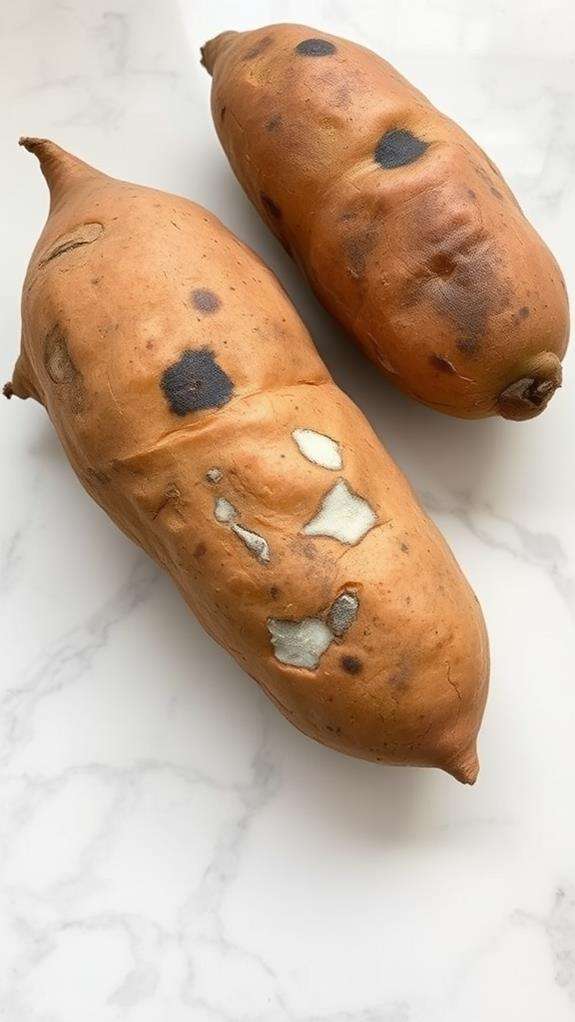
You'll want to check your sweet potatoes regularly for visual signs of spoilage, including dark spots, mold growth, or significant discoloration that differs from their typical orange-brown exterior. Crucial to be vigilant as spoiled sweet potatoes can harbor harmful bacteria, similar to how expired tofu poses food safety risks. When examining stored sweet potatoes, pay close attention to any unusual or off-putting odors, as fermentation or roting often produces distinct musty or sour smells. The texture of your sweet potatoes should remain firm and solid, so if you notice any soft spots, mushiness, or areas that feel hollow when gently pressed, these changes indicate it's time to discard the vegetable.
Visual Spoilage Indicators
Signs of spoilage in sweet potatoes can be easily spotted through visual inspection. When examining your cooked sweet potatoes, you'll want to check for any discoloration that differs from their natural orange hue. Even if you've added brown sugar or maple syrup as a flavor enhancement, you should still be able to distinguish normal coloring from spoilage.
Look for any fuzzy or moldy patches, which typically appear as white, green, or black spots on the potato's surface. If you've stored your side dish with lemon juice to prevent browning, you'll still need to watch for these indicators. The texture and visual appearance of spoiled sweet potatoes often includes shriveling, sunken areas, or unusual dark patches that weren't present when first cooked. You'll notice that the flavor and texture will have changed substantially if spoilage has occurred.
When examining the surface, pay attention to any liquid seepage or sliminess, which indicates bacterial growth. If you spot dark or soft spots that seem to be spreading, or if there's an unusual sheen that wasn't present before, it's best to discard the sweet potatoes immediately.
Smell and Texture Changes
Beyond visual cues, smell and texture changes provide reliable indicators of sweet potato spoilage. When you're planning to reheat baked sweet potatoes, first check for any off-putting odors. Fresh sweet potatoes should have an earthy, slightly sweet aroma, but if you detect any fermented, sour, or musty smells, it's time to discard them.
The texture of your leftover sweet potatoes can tell you a lot about their condition. Before reheating, gently press the surface – it should feel firm but yield slightly to pressure. If you notice any areas that are extremely soft, slimy, or watery, don't risk consuming them. When wrapped individually in foil for reheating, sweet potatoes should maintain their original texture. To avoid overcooking while achieving a crispy leftover exterior, pay attention to how the potato feels throughout the reheating process. A properly stored and reheated sweet potato will maintain its structural integrity, while spoiled ones often become mushy or develop an oddly grainy consistency. If you notice any unusual resistance when cutting into the potato or if the inside feels dried out and fibrous, these are clear indicators of quality degradation.
Quick Microwave Reheating Guide
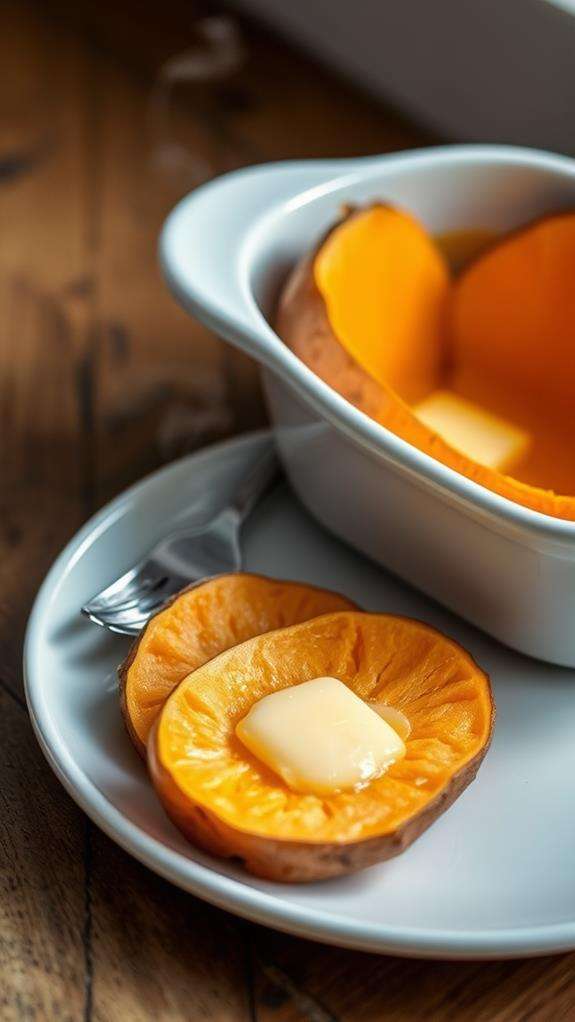
When you're ready to reheat your sweet potato in the microwave, you'll want to place it in a microwave-safe dish with a tablespoon of water and cover it with a paper towel to lock in moisture. For peak freshness retention, consider storing your sweet potato in a well-designed container like a HOMEKOKO Double Layer Bamboo Bread Box that checks humidity and air exposure. For the best results, set your microwave to high power and heat in 30-second intervals, checking frequently until your sweet potato reaches 165°F internally. Remember to slice larger sweet potatoes in half before reheating, and let them stand for 2 minutes after heating to confirm the temperature distributes evenly throughout.
Microwave Time and Settings
Mastering microwave timing is crucial for perfectly reheated sweet potatoes. When you're ready to reheat a whole sweet potato, you'll need to pierce it several times with a fork and microwave it on high power for 2-3 minutes, making certain to flip it halfway through the cooking process. Your microwave-safe dish should be positioned in the center of the turntable for even heating.
For diced or mashed sweet potatoes, you'll want to take a different approach. Start by heating them in 30-second intervals, stirring between each session to distribute the heat evenly. This method prevents cold spots and guarantees your reheated sweet potatoes maintain their texture. If you're working with sweet potato fries, they'll need shorter bursts of 20-30 seconds, with gentle shaking between intervals to help maintain their crispy exterior.
To prevent overcooking, always check your sweet potatoes after each minute of reheating. You can adjust the total time based on your microwave's power level and the portion size. Remember that smaller pieces will heat more quickly than whole potatoes, so monitor them carefully to achieve the perfect temperature.
Best Container Options
The right container choice plays a key role in successfully reheating your sweet potatoes. When you're ready to reheat sweet potato leftovers, selecting a microwave-safe dish or bowl made of glass or ceramic will guarantee safe and effective heating. You'll want to avoid metal containers that can cause dangerous sparking, and steer clear of plastic containers that might melt or release chemicals into your food.
| Container Type | Best For | Not Recommended For | Safety Level |
|---|---|---|---|
| Glass Dish | All sweet potato types | None | Excellent |
| Ceramic Bowl | Mashed sweet potatoes | None | Excellent |
| Paper Plates | Single layer reheating | Mashed varieties | Good |
| Plastic Containers | Not recommended | All types | Poor |
For reheating sweet potatoes effectively, cover the dish with a paper towel or microwave-safe lid to maintain moisture. If you're working with mashed sweet potato, opt for a shallow microwave-safe dish to promote even heating throughout. When reheating sweet potato wedges or fries, arrange them in a single layer on your chosen dish to maintain their texture and guarantee uniform heating.
Moisture Control Tips
Proper moisture control lies at the heart of successfully reheating sweet potatoes in your microwave. When you're ready to reheat your cooked sweet potatoes, you'll need to take specific steps to prevent them from drying out and becoming unpalatable.
To maintain ideal moisture while reheating, add a tablespoon of water or stock to your sweet potato before placing it in the microwave. You'll want to cover the potato with a paper towel or microwave-safe lid, which creates a steam environment and guarantees even heating throughout. If you're working with mashed sweet potatoes, remember to stir them every 15-20 seconds to distribute heat and moisture uniformly.
Watch your timing carefully, as it'll vary depending on your potato's size. Start with 30 seconds for a medium-sized sweet potato, adding more time in short intervals if needed. You'll notice the texture becoming softer as it heats, so adjust your microwave's power level accordingly. For multiple sweet potatoes, increase your heating time proportionally, but continue monitoring to prevent excessive softening or moisture loss.
Oven Reheating Steps
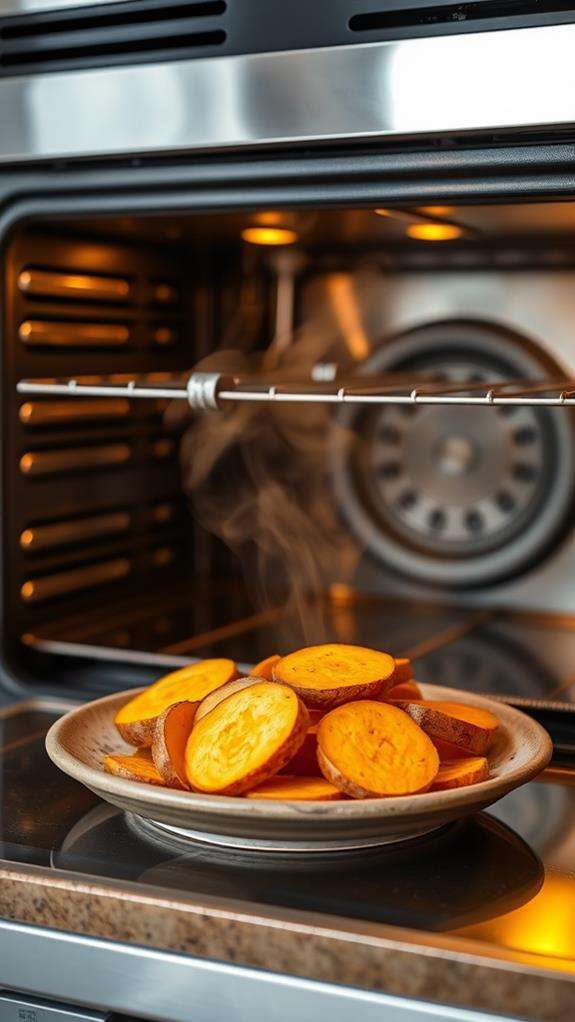
Reheating sweet potatoes in the oven starts with preheating to 400°F (200°C). While your oven's heating up, you'll want to prepare your baking sheet by lining it with either parchment paper or aluminum foil, which prevents sticking and makes cleanup easier.
Place your sweet potatoes on the prepared baking sheet and cover them completely with aluminum foil to lock in moisture. They'll need about 15-20 minutes to heat through properly. If you're after crispy skins, you can leave them uncovered during the last 10-15 minutes of reheating, but you'll need to watch them carefully to prevent burning.
Don't forget to check your sweet potatoes every 5 minutes during the reheating process. This frequent monitoring guarantees they won't overcook and helps you achieve the perfect temperature throughout. Before serving, let them rest for 2 minutes, and verify they've reached a safe internal temperature of 165°F (74°C). This resting period allows the heat to distribute evenly throughout the potato, certifying a consistently warm eating experience.
Air Fryer Sweet Potato Tips
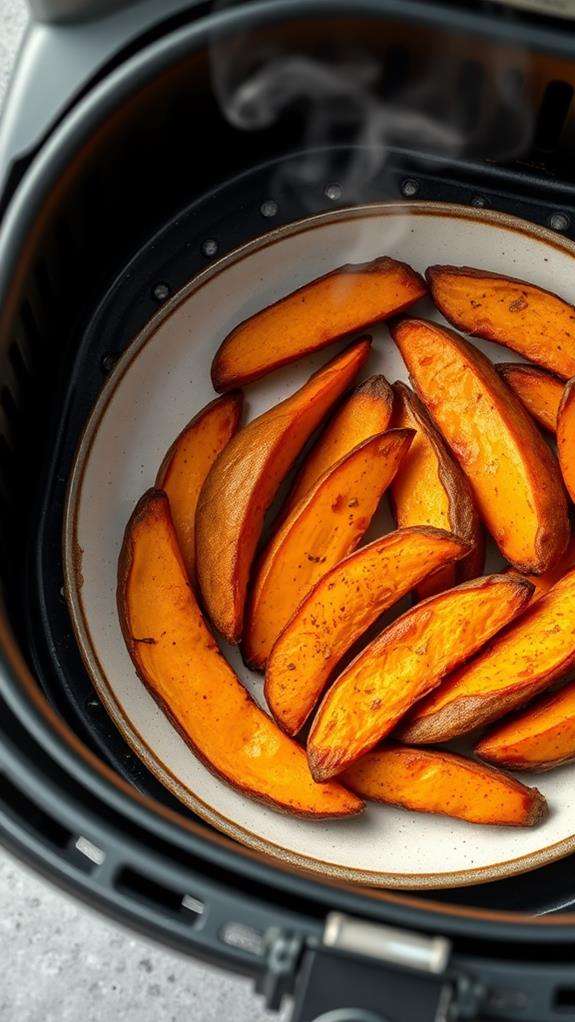
Air fryers offer a quick and convenient way to restore leftover sweet potatoes to their original glory. When you're ready to reheat your sweet potatoes, start by preheating your air fryer to 350°F, which helps guarantee even cooking and perfect crispiness. If you're working with sweet potato wedges, you'll want to arrange them in the air fryer basket in a single, even layer to prevent overcrowding.
Before placing your reheated sweet potatoes in the basket, lightly brush them with a little oil to help maintain moisture and enhance crispiness. The quickest method takes just 3-5 minutes for smaller pieces, while whole sweet potatoes might need 8-10 minutes. You'll want to flip them halfway through the cooking process to verify even heating. If you notice your sweet potatoes starting to dry out, spritz them with a small amount of water or oil.
Keep an eye on the temperature, as air fryers can heat unevenly. For best results, check your sweet potatoes after the first few minutes, and adjust the cooking time based on their size and initial temperature. They're done when they're heated through and slightly crispy on the outside.
Sweet Potato Fries Revival
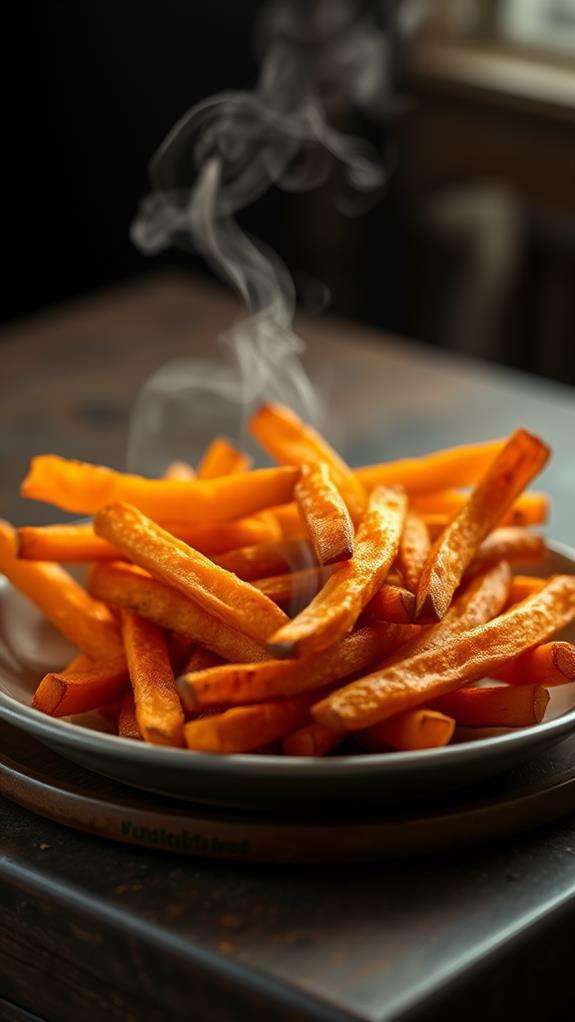
Crispy sweet potato fries can regain their delicious texture with the right reheating method. When you're looking to revive your leftover sweet potato fries, you'll find several effective approaches that preserve their crispiness and flavor.
| Method | Time | Temperature |
|---|---|---|
| Oven | 5 min | 400°F |
| Air Fryer | 2-3 min | 350°F |
| Stovetop | 4 min | Medium-high |
The best way to reheat sweet potato fries is in the oven, which certifies even heating and maintains that coveted crispiness you're after. If you're short on time, your air fryer offers a quicker alternative, delivering excellent results in just 2-3 minutes at 350°F. For a stovetop revival, you'll need a light coating of oil and about 4 minutes of cooking time, stirring occasionally to prevent sticking. While you might be tempted to use your microwave, it's best to avoid this method as it'll leave you with soggy fries. By choosing the right reheating method, you're not only preserving the quality of your leftovers but also reducing food waste and saving valuable prep time.
Mashed Sweet Potato Warming Methods
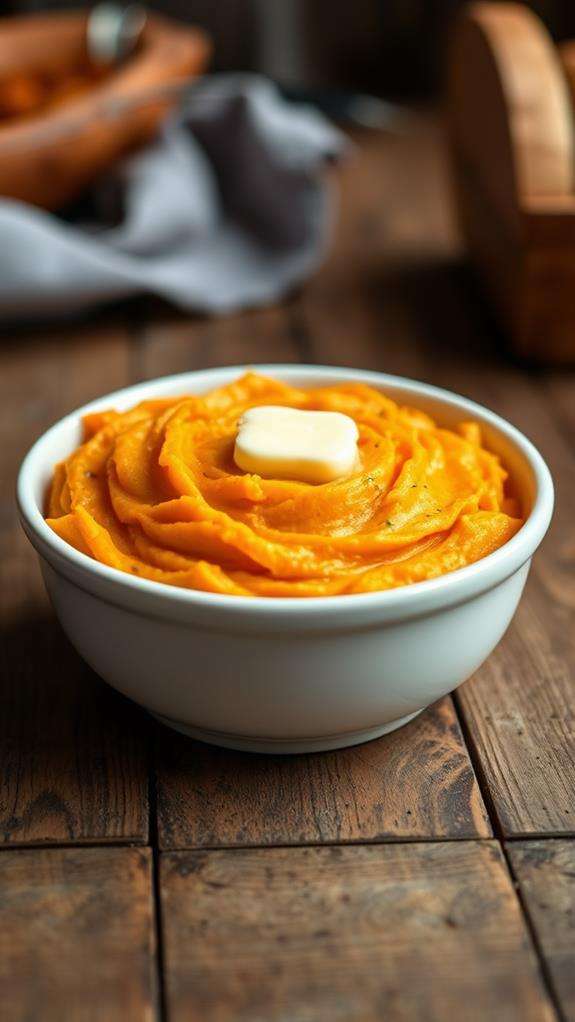
While mashed sweet potatoes make a delicious side dish, they often need proper rewarming to maintain their creamy texture and rich flavor. When you're ready to reheat your sweet potato dish, you'll find several effective methods at your disposal, each offering unique advantages for bringing back that fresh-made taste.
- For quick results, place your mashed sweet potatoes in a microwave-safe dish with a tablespoon of liquid, cover, and heat for 30-60 seconds
- On the stovetop, combine your mashed sweet potatoes with a splash of milk or water in a saucepan, stirring constantly over low-medium heat
- To reheat larger portions, use the oven method by covering your dish with foil and warming at 350°F for 10-15 minutes
- Always add a small amount of liquid before reheating to prevent drying and guarantee even warming
The versatility of reheated mashed sweet potatoes extends beyond traditional side dishes. You can repurpose your warmed sweet potatoes as a topping for breakfast bowls, mix them into yogurt for added nutrition, or even serve them alongside your favorite protein for dinner. Remember to stir occasionally during reheating to maintain that smooth, creamy consistency you love.
Frequently Asked Questions
Can You Reheat Cooked Sweet Potatoes?
Yes, you can definitely reheat cooked sweet potatoes using several methods. You'll get the best results by reheating them in a 425°F oven for 7-10 minutes, though you can also use a microwave or stovetop. Make sure to heat them to 165°F internally for food safety. To prevent drying, add a little water, stock, or oil. You can store reheated sweet potatoes in the fridge for up to five days or freeze them for up to a year.
Can You Heat up a Sweet Potato in the Microwave?
Yes, you can quickly heat up a sweet potato in the microwave! Studies show it's the fastest reheating method, taking just 2-3 minutes compared to 15-20 minutes in a conventional oven. Simply place your sweet potato in a microwave-safe dish, add a tablespoon of water, and cover with a paper towel. Remember to rotate halfway through cooking and let it rest for 2 minutes after heating. You'll know it's ready when it's steaming and tender.
What Is the Best Way to Reheat Baked Potatoes?
To get the best results when reheating baked potatoes, you'll want to use your oven at 400°F. Wrap your potatoes in aluminum foil and heat them for 15-20 minutes until they're thoroughly warmed. If you're short on time, you can use your microwave, but you'll lose the crispy skin texture. For a nice compromise, try your air fryer – it'll give you crispy results in 8-12 minutes while maintaining the potato's natural texture.
Can You Eat Cooked Sweet Potatoes the Next Day?
Yes, you can definitely eat cooked sweet potatoes the next day, and they'll stay good for up to 5 days when properly stored in your refrigerator. Just make sure you're storing them in an airtight container or zip-top bag to maintain freshness and prevent contamination. When you're ready to eat them, reheat them thoroughly to 165°F (74°C) for food safety. They'll taste great and can be used in various dishes.





